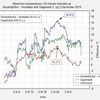30.3.2012 | 14:23
A new March maximum temperature record in Iceland
The last week has been warm in Iceland, especially in the north and east. Daily station records have been exceeded by the hundreds and also daily countrywide maxima on a few days. On Thursday 29 March the temperature at the farm Kvķsker on the Southeast coast the maximum temperature reached 20.5 degrees C. This is a new March record for the whole of Iceland exceeding the old one by the large margin of 1.7 deg C.
The old record, 18.8 deg C, was set on 28 March 2000 in the town of Eskifjöršur in the Eastern Fjords.
The individual monthly temperature maxima in Iceland are:
| Mon | Year | Month | Day | maximum °C | Station | ||
| January | 2000 | 1 | 15 | 19,6 | Dalatangi | East | |
| February | 1998 | 2 | 17 | 18,1 | Dalatangi | East | |
| March | 2012 | 3 | 29 | 20,5 | Kvķsker | Southeast | |
| April | 2007 | 4 | 29 | 23,0 | Įsbyrgi | Northeast | |
| May | 1992 | 5 | 26 | 25,6 | Vopnafjöršur | Northeast | |
| June | 1939 | 6 | 22 | 30,5 | Teigarhorn | East | |
| July | 1946 | 7 | 17 | 30,0 | Hallormsstašur | East | |
| August | 2004 | 8 | 11 | 29,2 | Egilsstašaflugvöllur | East | |
| September | 1949 | 9 | 12 | 26,0 | Dalatangi | East | |
| October | 1973 | 10 | 1 | 23,5 | Dalatangi | East | |
| November | 1999 | 11 | 11 | 23,2 | Dalatangi | East | |
| December | 2001 | 12 | 14 | 18,4 | Saušanesviti | North |
The official statement of the Icelandic Meteorological Office.
Dalatangi is a lighthouse on an peninsula at the East coast. It often experiences short „heat waves“ caused by decending warm air aloft along the very steep mountainside on the peninsula. The Dalatangi winter maxima have no diurnal preferences and often occur in the middle of the night. The station is however one of the most oceanic in Iceland the annual range of monthly temperatures is only 8.2 degrees C. At a few oceanic stations the heat waves of winter occasionally offer the highest maxima of the year. Later, I will give a list of these at this blog.
The station Saušanesviti (Saušanes lighthouse) is on the tip of a peninsula in the North, the topographical conditions are similar to the ones at Dalatangi.
The topography at Teigarhorn in the East is also similar to Dalatangi and Saušanesviti. The warm descending winds are not as common as in the other locations, but the aspect to the noon sun in summer is more favourable.
Kvķsker is located near the highest mountain in Iceland, Öręfajökull (a dormant volcano). The maxima at Kvķsker typically occur in westerly winds blowing along the side and downwards the slope near the station.
The remaining stations are all located in the valleys of the northeast and east. Vopnafjöršur at the seaside in a broad fjord, Įsbyrgi in a very broad valley, but not far from the coast and Hallormsstašur and Egilsstašir airport well inland in the largest valley of the East.
Um bloggiš
Iceland Weather blog
Nżjustu fęrslur
- Unusually high temperatures
- Unusually high sea level pressure
- Sea level pressure: Unusually low in Iceland this winter
- A new national maximum temperature record for December
- A new sea level pressure record for June in Iceland
- An unusually warm April in Iceland
- A new October high pressure record in Iceland
- A new absolute September maximum temperature record in Iceland
Heimsóknir
Flettingar
- Ķ dag (23.4.): 1
- Sl. sólarhring: 1
- Sl. viku: 15
- Frį upphafi: 10262
Annaš
- Innlit ķ dag: 1
- Innlit sl. viku: 15
- Gestir ķ dag: 1
- IP-tölur ķ dag: 1
Uppfęrt į 3 mķn. fresti.
Skżringar

 hoskibui
hoskibui
 svatli
svatli





Bęta viš athugasemd [Innskrįning]
Ekki er lengur hęgt aš skrifa athugasemdir viš fęrsluna, žar sem tķmamörk į athugasemdir eru lišin.